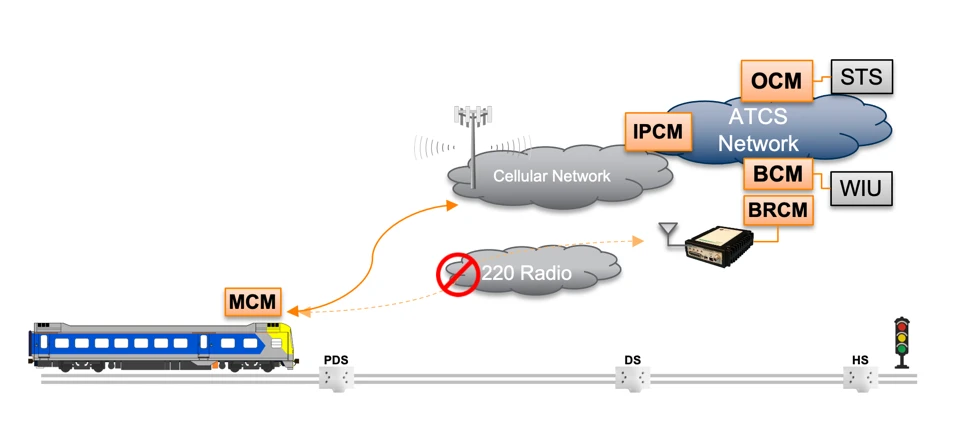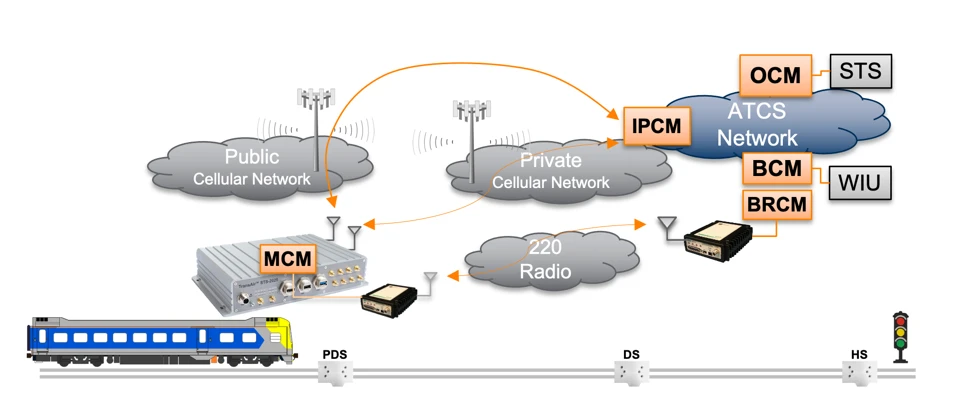Operational Risks for the Northeast Corridor Rail Line
Positive Train Control (PTC) is a communication-based train control system designed to prevent train accidents by automatically controlling train speeds and movements if the train operator fails to take the appropriate action. There are two main PTC systems, I-ETMS (Interoperable Electronic Train Management System) and ACSES (Advanced Civil Speed Enforcement System), both of which reply on reliable wireless communications to transmit train control messages in a timely manner. Carrying over 800,000 passengers daily, the Northeast Corridor is the nation’s busiest passenger rail line that uses the ACSES PTC system. Timely updates of PTC messages, such as the interlocking signal status and temporary speed restrictions, are critical for safe and efficient train operations.
However, the train-to-ground communication of the ACSES PTC system is currently based on the 220 MHz radio spectrum, and the lack of communication redundancy and diversity is creating operational risks to the Northeast Corridor rail operators. For example, a missing or delayed PTC message could cause the onboard system to fall back to the most conservative speed restriction, resulting in train delays, train stops, and reduced passenger satisfaction.
Communication Capacity and Reliability Concerns with a Single 220 MHz Radio
The number of trains, the complexity of the interlocking, and the amount of data to be sent onto the onboard systems all affect the bandwidth utilization of the 220 MHz base stations in the Northeast Corridor. Taking the Harold Interlocking for example, the large railroad junction in New York with over 40 trains per hour during rush hour, the train operations can easily consume all the available bandwidth with no headroom for re-transmission or error recovery.
Besides the capacity challenge, it is also difficult for the 220 MHz radio to stay reliable when it is the only wireless band and technology approach to support the ACSES PTC system’s communication volume on the busy Northeast Corridor. Interference, either caused by naturally occurring or manmade signal sources, can severely impact the performances of the wireless network relying on the a single 220 MHz radio band.
Communication Redundancy for Efficient and Safe Train Operations
Cellular radio technology is a very popular wireless communication option for today’s Supervisory Control and Data Acquisition (SCADA) applications and can deliver gigabit-level low-latency wireless connectivity at a reasonable cost. Many railroads have already taken advantage of this connectivity to enable over-the-air management of their assets on the locomotives, and now it can be adopted to increase the capacity and reliability of ACSES PTC communication. How does it work?
When the 220 MHz band is too congested and out of capacity, the Base Radio Communications Manager (BRCM) at the base station will notify the Mobile communications Manager (MCM) on the locomotive, and the MCM can immediately switch over to the cellular link and initiate train control message exchange using that link without waiting for the 220 MHz radio to become available again. A software component called IP Communication Manager (IPCM) is introduced to bridge the cellular connectivity into the Advanced Train Control System (ATCS) message routing network. The IPCM can then exchange dynamic ATCS route entries with the back office, which allows train control messages to be routed back to the MCM via the same cellular link as well. The cellular connectivity will be closed when the locomotive approaches the home signal (HS), just like the existing timeslot release process. The primary connectivity will then switch back to the 220 MHz radio after the locomotive passes through the HS.

In addition to congestion on the 220 MHz radio, interferences in the 220 MHz spectrum can also make the 220 MHz radio network unreliable. The MCM on the locomotive can seamlessly switch to alternative radio frequencies using both the public cellular and private cellular infrastructure. On the public infrastructure side, the LTE/5G cellular interface on the MCM can utilize frequencies ranging from 600 MHz to 6 GHz and provides ample frequency diversity to ensure network availability even when additional interferences are present, such as in the 600 to 700 MHz low band.
When the public cellular networks become unavailable during emergencies or natural disasters, the MCM can also seamlessly switch to the private LTE network using CBRS (Citizens Broadband Radio Service), Band 48, or the FirstNet® Band 14 infrastructure. The triple redundancy, disaster-resilient network design allows the communications system to tolerate congestions, interferences, and connectivity failure caused by weather-related factors or Denial-of-Service (DOS) attacks to the 220 MHz base station.

By implementing a communication redundancy solution, railroads can stay assured that train control messages continue to be available when the 220 MHz radio is too congested, is out of coverage, or suffers from interference. The result? Reduced train delays and improved rider satisfaction and rail safety.
Wireless Communication Security
Wireless security is another important consideration for train-to-ground communication. All PTC implementations using the existing 220 MHz radio network were required to comply with 49 CFR 236.1033 for wireless security, and the added redundant cellular connectivity also extends PTC’s secure wireless key management architecture and leverages the Transport Layer Security (TLS) protocol to facilitate privacy and data security for communications over the cellular network. Specifically, a secure TLS tunnel is established between the MCM and IPCM to ensure that the exchange of train control messages via the cellular network is also 49 CFR 236.1033-compliant, meeting the federal requirement: “all wireless communications between the office, wayside, and onboard components in a PTC system provide cryptographic message integrity and authentication.”
To learn more about how to securely increase communication capacity and redundancy for your ACSES PTC system, please contact our rail technology experts at info@lileesystems.com.
